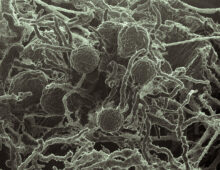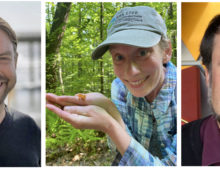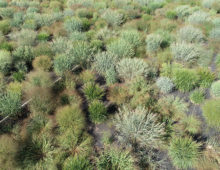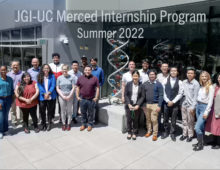Sequencing Sphagnum Leads to Discovery of Sex Chromosomes
Boggy peatlands, which hold much of the Earth’s carbon as well as material that can be converted to energy, are made up heavily of sphagnum mosses. [Read More]
![A photo of two sphagnum species: S. divinum (red) and S. angustifolium (green)]](https://jgi.doe.gov/wp-content/uploads/2023/04/Screen-Shot-2023-02-22-at-4.57.35-PM-220x170.png) Boggy peatlands, which hold much of the Earth’s carbon as well as material that can be converted to energy, are made up heavily of sphagnum mosses. [Read More]
Boggy peatlands, which hold much of the Earth’s carbon as well as material that can be converted to energy, are made up heavily of sphagnum mosses. [Read More] A new study offers the first irrefutable proof that anaerobic fungi — the kind living in the stomachs of livestock — can deconstruct lignin in the absence of oxygen. [Read More]
A new study offers the first irrefutable proof that anaerobic fungi — the kind living in the stomachs of livestock — can deconstruct lignin in the absence of oxygen. [Read More] New genomes highlight the diversity of white rot fungi in the genus Lentinula. [Read More]
New genomes highlight the diversity of white rot fungi in the genus Lentinula. [Read More] Learn about six proposals that will leverage the JGI’s DNA synthesis and omics capabilities to enhance understanding of gene and genome function. [Read More]
Learn about six proposals that will leverage the JGI’s DNA synthesis and omics capabilities to enhance understanding of gene and genome function. [Read More] Three new members have joined the JGI User Executive Committee, while six UEC members stepped down at the end of their terms. [Read More]
Three new members have joined the JGI User Executive Committee, while six UEC members stepped down at the end of their terms. [Read More] Long-term research investments in switchgrass genomics are helping these grasses become a key player in biomass-based fuels. [Read More]
Long-term research investments in switchgrass genomics are helping these grasses become a key player in biomass-based fuels. [Read More] Congratulations to the 2022 Highly Cited Researchers from the JGI recognized for their “significant influence by Clarivate Analytics. [Read More]
Congratulations to the 2022 Highly Cited Researchers from the JGI recognized for their “significant influence by Clarivate Analytics. [Read More] Twice each year, the JGI selects novel research projects through our New Investigator call under our Community Science Program. [Read More]
Twice each year, the JGI selects novel research projects through our New Investigator call under our Community Science Program. [Read More] To make fuels and chemicals from plants, we’ll need new ways of processing bark, shoots and leaves. Hear from JGI User Michelle O’Malley about the gut fungi that could be the key to better biomass breakdown. [Read More]
To make fuels and chemicals from plants, we’ll need new ways of processing bark, shoots and leaves. Hear from JGI User Michelle O’Malley about the gut fungi that could be the key to better biomass breakdown. [Read More] Hear the 2022 cohort of UC Merced undergraduate and graduate students share how their summer internship experiences at the JGI have influenced their careers in science. [Read More]
Hear the 2022 cohort of UC Merced undergraduate and graduate students share how their summer internship experiences at the JGI have influenced their careers in science. [Read More]